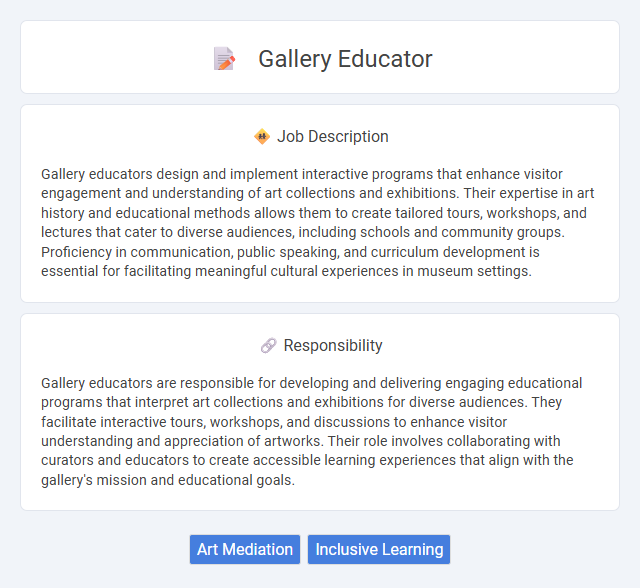
Gallery educators design and implement interactive programs that enhance visitor engagement and understanding of art collections and exhibitions. Their expertise in art history and educational methods allows them to create tailored tours, workshops, and lectures that cater to diverse audiences, including schools and community groups. Proficiency in communication, public speaking, and curriculum development is essential for facilitating meaningful cultural experiences in museum settings.
Individuals with strong communication skills and a passion for art will likely find the Gallery Educator role suitable, as it involves engaging diverse audiences and facilitating learning experiences. Those comfortable with public speaking and adaptable to varying group dynamics may have a higher probability of success in this position. Candidates who prefer solitary work or have limited interest in art education may find this job less fitting for their strengths and preferences.
Qualification
Gallery educators typically require a bachelor's degree in art history, education, or a related field, along with experience in museum or gallery settings. Strong communication skills and the ability to engage diverse audiences through interactive and interpretative programs are essential. Certification in education or specialized training in art interpretation enhances qualifications and career prospects.
Responsibility
Gallery educators are responsible for developing and delivering engaging educational programs that interpret art collections and exhibitions for diverse audiences. They facilitate interactive tours, workshops, and discussions to enhance visitor understanding and appreciation of artworks. Their role involves collaborating with curators and educators to create accessible learning experiences that align with the gallery's mission and educational goals.
Benefit
Gallery educator roles likely offer valuable opportunities to deepen art knowledge and improve public speaking skills, enhancing both personal and professional growth. Engaging with diverse audiences may increase cultural awareness and empathy, which can benefit future career prospects. The position probably provides a collaborative work environment, fostering networking and teamwork abilities.
Challenge
Gallery educator roles likely involve the challenge of continually adapting communication strategies to engage diverse audiences effectively. The position may require balancing deep artistic knowledge with accessible language, which can present ongoing difficulties. Handling varying visitor expectations and maintaining enthusiasm for educational content might also be demanding aspects of the job.
Career Advancement
A Gallery Educator role offers significant opportunities for career advancement in the arts and cultural sectors. Professionals can progress to curatorial positions, museum education coordinators, or program directors by developing expertise in art interpretation, educational programming, and audience engagement. Mastery of digital tools and inclusive educational strategies further enhances upward mobility within galleries, museums, and cultural institutions.
Key Terms
Art Mediation
Gallery educators specialize in art mediation by facilitating meaningful interactions between visitors and artworks, enhancing audience engagement through tailored educational programs. They design inclusive workshops and guided tours that interpret artistic concepts, fostering critical thinking and cultural appreciation. Proficiency in contemporary art theory and audience analysis enables gallery educators to connect diverse communities with the gallery's collection effectively.
Inclusive Learning
Gallery educators specialized in inclusive learning design engaging experiences that accommodate diverse audiences, including individuals with disabilities, different cultural backgrounds, and varied learning styles. They develop accessible educational programs and materials to ensure meaningful participation for all visitors. This role requires expertise in universal design principles, adaptive communication techniques, and collaboration with community partners to foster an inclusive environment.
 kuljobs.com
kuljobs.com